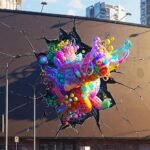The art world is transforming with tools like MidJourney, DALL·E and Stable Diffusion. These platforms allow anyone to conjure stunning visuals from text prompts, making creativity more accessible. This shift is reshaping artistic expression, challenging traditional boundaries and sparking debates about art’s essence, even as it impacts mediums like print.
How It Works
Sophisticated algorithms trained on vast datasets of artworks and photos generate images from prompts. The results span hyperrealistic landscapes to surreal dreamscapes, empowering creators to explore new artistic frontiers. This bypasses traditional art’s time-intensive processes and offers fresh possibilities for digital and physical works including prints, while inviting artists to rethink their craft.
Opportunities for Artists
This technology expands artistic horizons by lowering barriers. Creators can experiment with styles like cyberpunk or art deco and produce works for galleries, online platforms or limited prints. Niche aesthetics thrive, making art more diverse and inclusive. Picture transforming a sci-fi scene into a surrealist masterpiece—AI makes such visions accessible and enriches the art world’s diversity. This openness fosters collaboration where artists and audiences co-create, blending personal and algorithmic creativity.
Print Media’s Role
In print, AI art finds a tactile home that bridges digital innovation with physical expression. Artists use AI to design unique prints from posters to art books, preserving the medium’s artisanal charm. The accessibility of AI-generated designs revitalizes print and makes it affordable for indie creators to produce limited editions or custom pieces. Exhibitions featuring AI prints such as a futuristic cityscape on textured paper highlight print’s ability to amplify AI’s visual impact and offer audiences a sensory connection to digital art.
Challenges and Ethical Debates
Yet the volume of AI-generated works raises concerns. Critics argue these creations, while technically impressive, often lack the emotional depth of human art. Can an algorithm capture love’s joy or loss’s grief like a human artist? Ethical dilemmas also emerge: if AI draws from existing art, who owns the result? These questions challenge art’s authenticity and value, especially in exhibitions or print where provenance matters.
Innovation and Adaptation
Despite challenges, innovation flourishes. Artists blend AI designs with traditional techniques and create hybrid works that merge technology’s precision with human craftsmanship. Exhibitions showcasing these pieces like a hand-finished AI landscape print spark dialogue and blur the line between creator and machine. Such works invite viewers to rethink creativity’s boundaries.
The Future of Art
This evolution isn’t the end of art but an invitation to evolve. Artists must embrace AI and focus on qualities machines can’t replicate: emotion, intent and tactile depth. In print, this means valuing hand-pulled textures; in digital, it’s about personal storytelling. For audiences, AI offers fresh perspectives and makes art more inclusive. As technology advances, it will redefine creativity by blending human and machine for a richer artistic landscape. What role will you play in this new era?








